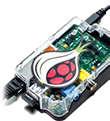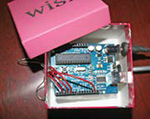PART 3
Microcontrollers AND Microcomputers
Before the Arduino came along, programming microcontrollers and integrating them into electronics projects was a job most hobbyists left to professional engineers. The genius of the Arduino project was to mount a microprocessor onto a development board with built-in inputs and outputs and develop an easy programming environment for it. This development put programming microprocessors within the reach of hobbyists, artists, and young students. Within a few years, the Raspberry Pi put the full power of a computer with a Linux operating system on one of those little boards. The revolution continues, and Make: magazine has been at the forefront from the beginning.

Dan Rasmussen is among many other Make: authors who are fascinated with vintage electronics—he even has a website called Retro-Tronics—and also with the latest cutting-edge technology. Dan’s “Million Color HSL Flashlight” project integrates the old and the new. It was inspired by his childhood love of flashlights that had colored lenses. But he updates that childhood toy by hacking a big 6-volt lantern with an Arduino and NeoPixel RBG LEDs to create a lightshow you can hold in your hand.

Jim Newell shows you how to use your Arduino to hack an X10 home automation module and expand its capabilities. Would you like your mailbox to alert you when the mail arrives? Why not have you outdoor lights turn on automatically when your car pulls into the driveway? The coding to get you there is easier than you might think, and—once you’re in—the possibilities are, as they say, limited only by your imagination.

Getting an Arduino to produce audio that goes beyond beeps and buzzes is a bit of a mystery for many. So it’s ironic that international man of mystery Jon Thompson steps in to demystify how it’s done.
Musician and artist Peter Edwards introduces you to the fun of circuit bending and electronic music in “Hack Electronic Pushbuttons.”
With Sam Freeman and Wynter Woods’ “Raspberry Pirate Radio,” we move from the Arduino to the Raspberry Pi single-board computer. It’s a clever title, but the cleverness doesn’t stop there. Sam and Wynter show you how to stick a wire into your Raspi to turn it into a transmitter, then modify the PiFM code to play back your music files continuously. All you have to do is tune your radio to the right channel, and you’re receiving! They even drew up a 3D-printable case for your transmitter to keep it stylish and safe.

You may have seen Limor Fried’s picture on the cover of Wired magazine. If you are into DIY electronics you’re undoubtedly familiar with her company, Adafruit Industries, which is a critical go-to source of products and information for makers. Limor and Adafruit creative director Phillip Torrone team up to show you how to turn your Raspberry into an anonymous Tor proxy.
